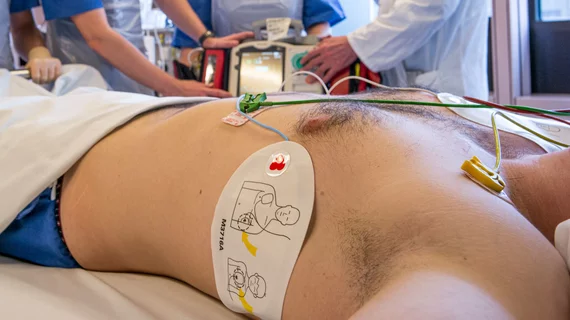New-look protocol boosts outcomes among AFib patients in the ER
A large proportion of patients with atrial fibrillation (AFib) end up in emergency rooms (ERs), but there are inherent issues with most hospital ERs handing off these patients to electrophysiologists for follow-up care. This has led to issues with patients receiving the care they need to properly manage their heart rhythm issues, and can lead to poor outcomes.
It was a late-breaking study at Heart Rhythm 2022, the annual meeting of the Heart Rhythm Society (HRS). The Clinical And Economic Impact Of An Organized Treatment Pathway On Atrial Fibrillation Patient From The Emergency Room To Electrophysiology Service (ER2EP Study), found getting AFib patients involved with a clearly organized pathway can lead to improved outcomes and reduced costs.
"This study provides evidence that having an organized pathway for AFib patients can lead to improved outcome times for AF ablation, anti-arrhythmic drugs, oral anticoagulant and length of stay," said Dhanunjaya Lakkireddy, MD, executive medical director of the Kansas City Heart Rhythm Institute at HCA Midwest in Overland Park, Kansas, who presented the study. "We hope such guidelines will boost the efficiency of ER as well as the healthcare systems in the management of AF."
The idea behind this study was to initiate appropriate, standardized referral protocol involving the electrophysiology service further management of AFib could significantly improve access to care and there by AF related complications and hospitalizations compared to routine care pathway that currently exists.
ER2EP Study is a multi-center, prospective observational registry (NCT04476524) with 400 patients enrolled between 2019-2021 and they were divided evenly between the ER2EP group and a control group. The ER2EP group included patients with new onset AFib triaged and treated by the ER physicians with simultaneous EP consultation either inpatients for those admitted and outpatient for those that are discharged from the ER. The control group of patients with new onset AFib who received routine care by the ER physicians with no concerted effort to consult EP. All the ERs and associated hospitals had the same group of electrophysiologists provide services. The study followed patients for 12 months.
Across the board, all average measures looked at in the study as primary and secondary endpoints in the study improved for patients in the ER2EP group vs. the control group:
• Time to EP evaluation: 1 vs. 128 days
• Time to Ablation: 52.8 vs. 180.6 days
• Time to Antiarrhythmic drugs: 2.7 vs 25 days
• Time to Oral Anticoagulation: 1.7 vs. 17 days
• Length of Stay: 2.35 vs. 5.84 days
• ER Visit for Heart Related Issues: 5% vs. 10%
• Congenstive heart failure: 4% vs. 8%
• Stroke: 5.5% vs. 7.5%
Lakkireddy said there are several benefits seen with earlier interventions in DEP patients. These include Early restoration of rhythm results in reduced mortality, stroke, and heart failure hospitalization. Early catheter ablation results in better rhythm control and minimizes recurrent hospitalizations. Earlier access to specialist care could potentially mitigate the inherent hurdles in navigating patients through complicated healthcare systems, he said.
Patient education, patient compliance, medication costs, access to comprehensive care, organized specialist care also play roles. These factors all impact the timely initiation of OAC, which continues to be a challenge in clinical practice, he explained.
ER might be a missed opportunity to optimize AF care
ER physicians have a unique opportunity not only to triage and provide emergency medical care but to potentially minimize the morbidity and mortality associated with AFib by directing these patients to appropriate service for improved and more directed care, Lakkireddy explained.
There is substantial variation in the ER practice patterns. This includes such as selecting rate vs. rhythm control, timing and need for initiating oral anticoagulation (OAC) for stroke prophylaxis, ER vs. inpatient treatment and cardiology consultation. Lakkireddy said all of these factors can lead to disparate patient care.
The idea behind this study was to initiate appropriate, standardized referral protocol involving the electrophysiology service further management of AFib could significantly improve access to care and there by AFib related complications and hospitalizations compared to routine care pathway that currently exists.
Links to all the Heart Rhythm 2022 late-breaking studies
Find more electrophysiology news

